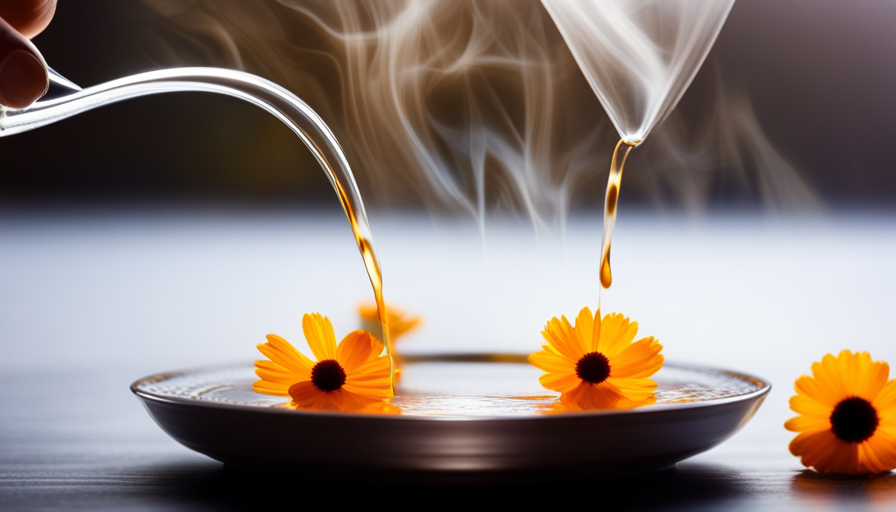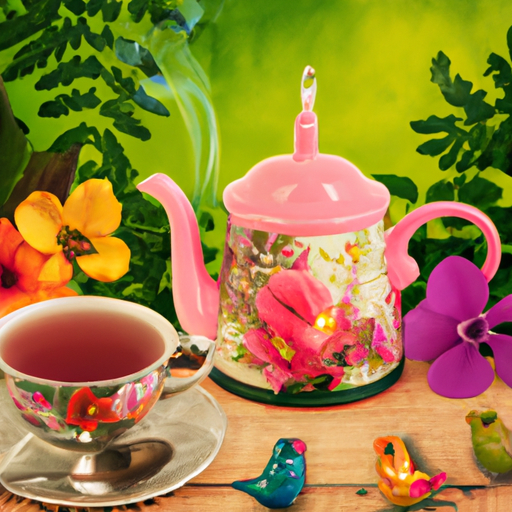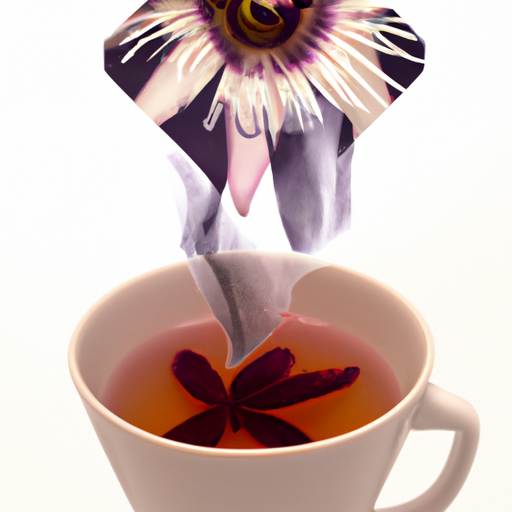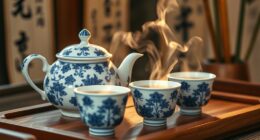According to the old saying, ‘A cup of tea is like a warm hug for the soul.’ Embrace the soothing powers of nature with a cup of whole calendula flower tea.
Calendula flowers, also known as marigolds, have been treasured for centuries due to their remarkable health benefits. Packed with antioxidants, anti-inflammatory properties, and a touch of sunshine in their vibrant petals, these flowers offer a delightful infusion that can uplift both body and spirit.
In this article, I will guide you through the process of making your very own calendula flower tea. From gathering fresh flowers to infusing them in boiling water, and even adding sweeteners if desired, we will explore the art of crafting a cup of tea that nourishes both the senses and the body.
So, let’s embark on this journey together and unlock the secrets of this remarkable beverage.
Key Takeaways
- Calendula flower tea is rich in antioxidants and anti-inflammatory properties, which can boost the immune system and promote skin health.
- To make whole calendula flower tea, fresh calendula flowers should be carefully harvested and air-dried until they become brittle.
- The dried calendula petals should be stored in an airtight container away from sunlight and moisture to maintain their quality.
- When making the tea, boiling water should be used to extract the active compounds from the calendula petals, and the tea should steep for 10-15 minutes to absorb colors, flavors, and properties.
Understanding the Benefits of Calendula Flowers
You’ll be amazed by the incredible benefits that calendula flowers can bring to your health and well-being. Calendula flowers, also known as pot marigold, have been used for centuries for their medicinal properties.
One of the most popular ways to enjoy their benefits is by brewing a cup of calendula flower tea. Calendula flower tea is known for its numerous health benefits. It’s rich in antioxidants, which can help protect your cells from damage caused by free radicals. These antioxidants can also help boost your immune system and reduce inflammation in the body. Additionally, calendula flower tea has been used to support healthy digestion and promote skin health.
When it comes to brewing calendula flower tea, it’s important to find the right dosage. Generally, a teaspoon of dried calendula flowers steeped in a cup of hot water for 10-15 minutes is a good starting point. However, it’s always best to consult with a healthcare professional to determine the appropriate dosage for your specific needs.
While calendula flower tea is generally safe for most people, it’s important to be aware of possible side effects. Some individuals may experience allergic reactions, such as skin rashes or itching. If you have any known allergies, it’s best to avoid calendula flower tea or consult with a healthcare professional before consuming it.
Now that you understand the benefits and possible side effects of calendula flower tea, let’s move on to the next step: gathering fresh calendula flowers.
Gathering Fresh Calendula Flowers
Start by gently plucking the vibrant, sunny petals from the calendula plant. The process of harvesting fresh calendula flowers is crucial in ensuring the quality and effectiveness of your tea. Choose flowers that’re fully bloomed and free from any signs of wilting or discoloration. It’s best to harvest the flowers in the morning when the petals’re at their freshest. Carefully remove the petals from the flower head, being mindful not to damage them.
Once you’ve gathered a sufficient amount of fresh calendula flowers, it’s important to dry them properly for storage. Lay the petals in a single layer on a clean, dry surface such as a paper towel or a mesh screen. Allow them to air dry in a well-ventilated area for about one to two weeks, or until they become brittle to the touch. This drying process helps to preserve the flowers’ medicinal properties and prevent mold or mildew growth.
To store the dried calendula petals, place them in an airtight container away from direct sunlight and moisture. This’ll ensure their longevity and maintain their potency for future use. Now that you’ve your dried calendula flowers ready, you can proceed to the next step of preparing the tea leaves, which’ll further enhance the health benefits of this delightful beverage.
Preparing the Tea Leaves
Once the dried petals are ready, it’s time to prepare the tea leaves. This can be done by steeping them in hot water for 5-7 minutes. Did you know that studies have shown that drinking herbal teas can increase hydration levels and contribute to daily water intake? Calendula flowers are known for their vibrant orange color and mild, earthy flavor. To enhance the taste and health benefits of the tea, you can experiment with different tea blends. For example, adding a pinch of chamomile or lavender can create a soothing and aromatic blend. As for steeping times, longer steeping times result in a stronger and more potent tea, whereas shorter steeping times result in a milder flavor. So, if you prefer a stronger taste, you can steep the tea leaves for closer to 7 minutes. On the other hand, if you prefer a milder flavor, you can steep them for around 5 minutes.
Now that the tea leaves are ready, let’s move on to boiling water and infusing the tea, which will further enhance its flavors and release its beneficial compounds.
Boiling Water and Infusing the Tea
To create a truly invigorating experience, imagine the steam rising from the bubbling pot of water as it’s preparing to infuse the vibrant calendula petals and release their aromatic essence.
Infusing techniques play a crucial role in extracting the maximum flavor and benefits from the flowers. Here are three essential steps to ensure a perfect infusion:
-
Boiling water: Start by bringing a pot of water to a boil. The boiling temperature is crucial as it allows the water molecules to extract the active compounds from the calendula petals effectively. Use filtered water to ensure the best taste and avoid any potential contaminants.
-
Adding the petals: Once the water reaches a rolling boil, carefully add the dried calendula petals to the pot. For a strong and flavorful tea, use a ratio of one tablespoon of petals per cup of water. Stir gently to submerge the petals completely.
-
Infusing time: Allow the tea to steep for about 10 to 15 minutes, depending on your desired strength. This duration allows the water to absorb the vibrant colors, delicate flavors, and beneficial properties of the calendula petals.
Transitioning into the subsequent section about adding sweeteners or enhancements (optional), the infused calendula tea provides a perfect base to explore different taste profiles and further elevate your tea experience.
Adding Sweeteners or Enhancements (Optional)
Enhancing the already aromatic and vibrant infusion, you can add a touch of sweetness or other flavor enhancements to elevate your tea experience. Sweeteners can balance the herbaceous flavors of calendula and create a more enjoyable taste. If you prefer to avoid refined sugars, there are various sweetener alternatives available. Some popular options include honey, maple syrup, and stevia. These natural sweeteners not only add sweetness but also bring their unique flavors and health benefits to the tea. Experimenting with different flavor combinations can further enhance your tea. You can try adding a slice of lemon or a sprig of fresh mint for a citrusy and refreshing twist. If you prefer a floral note, a drop of rose water or lavender syrup can create an exquisite flavor profile. Don’t be afraid to get creative and explore different combinations to find your perfect cup of calendula flower tea. By allowing the tea to steep and release its flavors, you will unlock the full potential of this delightful beverage. Now, let’s move on to the next step of the tea-making process.
Allowing the Tea to Steep and Release Its Flavors
Indulge in the full sensory experience of your brew by allowing the tea to steep, unlocking a symphony of flavors that’ll transport you to a world of pure relaxation and delight.
The process of steeping allows the calendula petals to infuse their therapeutic properties into the water, creating a soothing and aromatic elixir. To ensure the best results, it’s important to follow proper infusing techniques.
Start by boiling water and then pouring it over the dried calendula flowers in a heat-resistant container. Cover the container with a lid or a plate to trap the steam and let it steep for about 10-15 minutes. This steeping time allows the water to extract the essential oils, antioxidants, and other beneficial compounds present in the petals.
During this time, the water will turn into a vibrant golden hue, indicating that the tea is ready to be enjoyed. The longer you steep the tea, the stronger the flavor will be, but be cautious not to oversteep as it may result in a bitter taste.
Once the steeping is complete, strain the tea to remove the petals and other particles, and then it’s ready to be served.
Transitioning into the subsequent section about straining and serving the tea, you can now move on to the final steps of preparing and savoring this delightful beverage.
Straining and Serving the Tea
Once the tea has finished steeping, strain it to remove any particles and prepare to serve a delightful and aromatic cup of golden elixir. Straining the tea is a crucial step to ensure a smooth and enjoyable drinking experience. There are various straining techniques you can employ to achieve the desired result. One option is to use a fine-mesh sieve or cheesecloth to strain the tea directly into your teacup. This method effectively removes any residual flower petals or debris, leaving behind a clear and pristine liquid. Another technique is to use a tea strainer or infuser, which allows for easy removal of the tea leaves while preserving the flavors and aromas.
To enhance the presentation and evoke a sense of tranquility, consider serving the calendula flower tea in a delicate teacup. The golden hue of the tea will beautifully contrast with the cup, creating an inviting visual appeal. For a unique twist, you can also serve the tea over ice, garnished with a sprig of fresh mint or a slice of lemon. This refreshing alternative is perfect for warmer days or when you desire a chilled beverage.
As you strain and serve the calendula flower tea, the aromas of the delicate petals will waft through the air, tantalizing your senses. The next section will delve into the enjoyment of the aromas and tastes of this exquisite tea, allowing you to fully appreciate its therapeutic benefits.
Enjoying the Aromas and Tastes of Calendula Flower Tea
As you savor the fragrant bouquet and distinctive flavors of this enchanting infusion, you’ll be transported to a realm of sensory delight. Calendula flower tea not only offers a delightful experience for the senses but also opens up a world of possibilities when it comes to exploring herbal tea alternatives.
Here are three ways you can further enhance your tea-drinking journey:
-
Blending with other teas: Experimenting with different tea blends can create new and exciting taste profiles. Consider combining calendula flower tea with chamomile for a soothing and calming blend, or mix it with peppermint for a refreshing and invigorating combination.
-
Adding natural sweeteners or herbs: To enhance the flavors of calendula flower tea, you can add a touch of honey or stevia for a hint of sweetness. Alternatively, adding a sprig of lavender or a slice of lemon can introduce complementary herbal notes to the tea.
-
Adjusting steeping time and temperature: The strength and intensity of the aromas and flavors can vary depending on the steeping time and temperature. Experiment with different steeping times and temperatures to find the perfect balance that suits your taste preferences.
By exploring these tea-blending techniques and experimenting with different flavors, you can create a personalized tea experience that suits your unique palate.
Now, let’s delve into the health benefits of calendula flower tea.
Exploring the Health Benefits of Calendula Flower Tea
Are you curious about the potential health benefits that can be derived from enjoying a cup of this vibrant and soothing herbal infusion? Calendula flower tea has been used for centuries and has a rich history of medicinal use.
It is believed to have anti-inflammatory properties, which can help reduce inflammation in the body. Additionally, calendula flower tea contains antioxidants that can protect against oxidative stress and help boost the immune system.
Understanding the cultural significance of calendula flower tea is also important. In many cultures, calendula has been used to promote healing and skin health. It has been traditionally used to treat wounds, burns, and rashes due to its antibacterial and antifungal properties. Calendula flower tea is also known for its soothing effects, making it a popular choice for promoting relaxation and reducing anxiety.
Incorporating calendula flower tea into your daily routine can be a great way to support your overall well-being. Whether you enjoy it for its potential health benefits or simply for its delightful taste and aroma, this herbal infusion can be a wonderful addition to your tea collection.
As you continue on your journey of exploring the world of calendula flower tea, you may be wondering how to store and preserve it to maintain its freshness and potency.
Storing and Preserving Your Calendula Flower Tea
Now that we’ve explored the numerous health benefits of calendula flower tea, it’s important to know how to properly store and preserve this delightful beverage. Preserving your calendula flower tea ensures that you can enjoy its health benefits for a longer period of time.
There are several methods you can use to preserve your calendula flower tea. One effective method is to store it in an airtight container, such as a glass jar, away from direct sunlight and moisture. This helps to maintain the tea’s freshness and potency.
Another method is to freeze your calendula flower tea. Freezing helps to extend its shelf life while preserving its beneficial compounds. Simply pour the tea into ice cube trays and place them in the freezer. This way, you can easily thaw out a cube whenever you want to enjoy a cup of calendula tea.
It’s important to note that the health benefits of calendula tea may diminish over time, so it’s best to consume it within six months of preparation. Additionally, be sure to check for any signs of spoilage, such as a change in color or odor, before consuming the tea.
By following these simple preserving methods, you can continue to reap the health benefits of calendula flower tea long after it’s brewed. So go ahead, brew a fresh cup and savor the natural goodness of this remarkable herbal infusion.
Frequently Asked Questions
Can I use dried calendula flowers instead of fresh ones?
Yes, you can use dried calendula flowers instead of fresh ones to make calendula flower tea. Drying calendula flowers is a common method of preserving them for later use. While dried flowers may not retain the same vibrant color and aroma as fresh ones, they still offer many benefits.
Calendula flowers are rich in antioxidants and have anti-inflammatory properties, making them a great addition to your tea for promoting overall wellness.
How long does it take for the tea to steep and release its flavors?
Ah, the art of steeping tea. It’s a dance between patience and anticipation. When it comes to calendula flower tea, the steeping time is crucial for optimal flavor release. Typically, it takes around 10-15 minutes for the tea to steep and infuse its vibrant flavors into the water.
During this time, the delicate petals slowly surrender their essence, creating a soothing elixir that delights the senses.
So, sit back, relax, and let the tea work its magic.
Can I add milk or cream to the calendula flower tea?
Yes, you can add milk or cream to calendula flower tea. However, it’s important to note that adding milk may alter the flavor and aroma of the tea. Calendula flower tea is known for its numerous health benefits, such as its anti-inflammatory and antioxidant properties. Adding milk or cream can provide a creamy texture and enhance the taste, making it a soothing and enjoyable beverage.
Are there any potential side effects or allergies associated with drinking calendula flower tea?
There are potential side effects and allergies associated with drinking calendula flower tea. Some people may experience allergic reactions, such as skin rashes or itching. It’s important to start with a low dosage and gradually increase it to avoid any adverse reactions.
Calendula tea has been known for its potential health benefits, including anti-inflammatory and antioxidant properties. However, it’s always recommended to consult with a healthcare professional before incorporating any new herbal tea into your diet.
How long can I store the brewed calendula flower tea before it goes bad?
The shelf life of brewed calendula flower tea is typically around 2 to 3 days when stored properly. To ensure its freshness, store it in a sealed glass container in the refrigerator. Avoid exposure to direct sunlight or extreme temperatures, as this can degrade the tea’s quality.
It’s important to note that the taste and potency of the tea may diminish over time, so it’s best to consume it within a few days for optimal benefits.
Conclusion
In conclusion, creating a cup of comforting and beneficial calendula flower tea is a simple yet rewarding process. By understanding the benefits of these beautiful flowers, gathering them fresh, and preparing the leaves properly, you can unlock a world of health benefits.
Boiling water and infusing the tea allows the flavors and nutrients to meld together, and adding sweeteners or enhancements is an optional indulgence. Straining and serving the tea completes the process, allowing you to savor the delightful aromas and tastes of this herbal concoction.
Finally, storing and preserving your calendula flower tea ensures that you can continue to enjoy its goodness for days to come. So go ahead, indulge in this delightful and scientifically proven elixir, and let the alluring allure of calendula flower tea captivate your senses.










